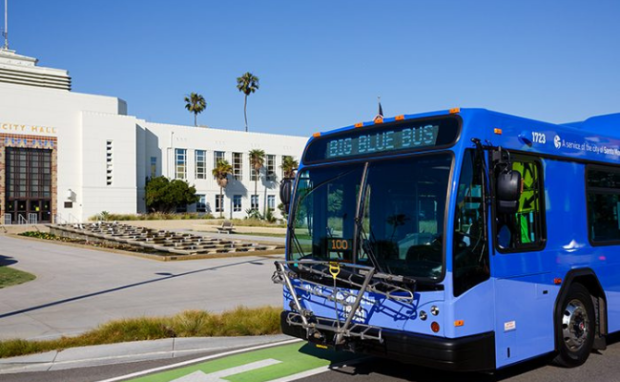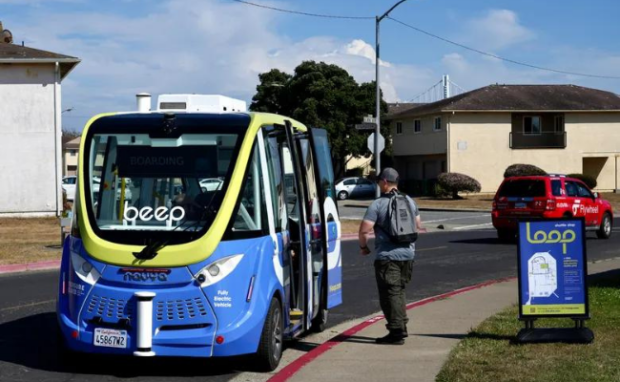Santa Monica launches AI ticketing cameras on buses
Santa Monica, California, began testing AI ticketing cameras attached to buses. They check the road for illegally parked vehicles as public transport moves through the city. Robert McCall, the Community Engagement Manager for Santa Monica City, said, “Our goal is not to issue citations, but our goal is to change behavior.”
More urban areas like Santa Monica are trying to improve public services with artificial intelligence and other advanced technologies. Learning more about their projects lets us peek into the city of the future. More importantly, your country will inevitably implement them soon, so you should see how they will transform your neighborhood.
This article will discuss how Santa Monica tests its AI-powered ticketing system. Later, I will share other AI projects that will transform public transportation worldwide.
How do the AI ticketing cameras work?

Photo Credit: intelligenttransport.com
KTLA reported Santa Monica City tested this technology with its Big Blue Bus Line. They provided 7.7 million trips last year, but many weren’t on schedule due to traffic violations.
They struggled to be on time due to cars improperly stopped in dedicated bus lanes. In response, Robert McCall thought, “The question becomes how do we and other cities keep vehicles that should not be in the transit lane out of the lane.”
The city partnered with smart enforcement tech firm Hayden AI to stop these violations with AI ticketing cameras on buses. Here’s how it works:
- They capture the license plates of cars in improper spots.
- Next, the AI ticketing cameras send data to a computer box on the bus.
- That server uses artificial intelligence processes what’s happening in the photos.
- Then, this system flags cars breaking the rules.
- Afterward, it submits reports to Santa Monica authorities to issue tickets quickly.
You may also like: Elon Musk teases new Tesla cars
KTLA says the city’s 45-day trial program identified more than 500 potential violations, costing roughly $300 each. Santo Monica says it does not use this system to make money.
Hayden AI representative Charlie Territo reiterated a similar sentiment. “We don’t make any more or any less depending on the number of violations that are captured.” Also, city official Robert McCall said, “Our goal is not to issue citations, but our goal is to change behavior.
Is there another AI public transport project in CA?

Photo Credit: seattletimes.com
Besides the AI ticketing camera system, San Francisco is also running a similar project. It runs on a fixed route called the Loop around Treasure Island, a former US Navy Base site in San Francisco Bay. Even better, everyone can try it for free!
It makes seven stops connecting residential neighborhoods with roughly 2,000 people. Also, its all-electric vehicle doesn’t have a steering wheel or driver’s seat.
Still, it has a human attendant ready to take control with a handheld controller if an emergency arises. As a result, passengers said they felt secure inside the driverless bus.
“I didn’t feel unsafe,” said Dominic Lucchesi, an Oakland resident, who was one of the first to test the autonomous service. “I thought that it made some abrupt stops, but otherwise, I felt like I was riding any other bus for the most part.”
Tilly Chang, executive director of the San Francisco County Transportation Authority, explained, “Having the attendant on board makes everyone feel comfortable.”
“This is just a demonstration for now to see, ‘What does it look like, and how does it work to have a driverless shuttle in a low-volume, low-speed environment?’”
Beep, a Florida-based company, operates the free shuttle service. Its project manager, Shelley Caran, reiterated, “These shuttles are built for first-mile, last-mile, short connectivity routes. They’re not intended to take the place of a bus system.”
“The autonomous vehicle will have a better reaction time than a human, and it will offer a more reliable service because they won’t be distracted.”
Contrary to popular belief, these vehicles may bring more jobs. Nikolas Martelaro, a driverless vehicle researcher at Carnegie Mellon University, stated, “Trained operators are going to be required even as we increase automation.”
What are other AI upgrades to public transportation?
Photo Credit: traffictechnologytoday.com
That city in the Golden State isn’t the only one exploring AI public transport applications. For example, Tesla is world-famous for its self-driving EVs.
Its automobiles haven’t achieved full self-driving capabilities because human drivers should still be ready to control them in emergencies. However, CEO Elon Musk promised to significantly upgrade his electric cars during last year’s Tesla AI Day.
He mentioned features like autopark, autosteer, and auto lane change, which his products have nowadays. Moreover, he promised Tesla would have an autotaxi service.
Musk dubbed his driverless taxi service the “Tesla Network.” As the name suggests, it will be like San Francisco’s driverless bus system. However, he claimed he will only launch it once Tesla achieves “full self-driving capabilities.”
That means his electric cars should be able to take you anywhere you want without being in the driver’s seat. You can sleep or do other activities on the road because this future vehicle would be 100% safe.
You may also like: Hacker discovers “Elon Mode” in Tesla cars
The company hasn’t achieved this feat at the time of writing, so it hasn’t launched its autotaxis yet. Nevertheless, North Carolina State University is preparing for a future dominated by driverless automobiles.
Believe it or not, its researchers discovered we need a fourth traffic light in the future. It will be white and signal drivers to allow AI-driven vehicles to move first.
Then, they should follow their lead to ensure smooth traffic flow. No city has implemented this proposal at the time of writing, but we might see it soon.
Conclusion
Santa Monica City is testing a pilot program for an AI ticketing camera system. Its vehicles have attendants on standby, so passengers feel safe riding them.
Hayden AI installed this system in Washington and New York City. Soon, more countries may launch similar AI programs as testing continues.
You might hop on a driverless bus, train, plane, or taxi on your next commute! Learn more about the latest digital tips and trends at Inquirer Tech.